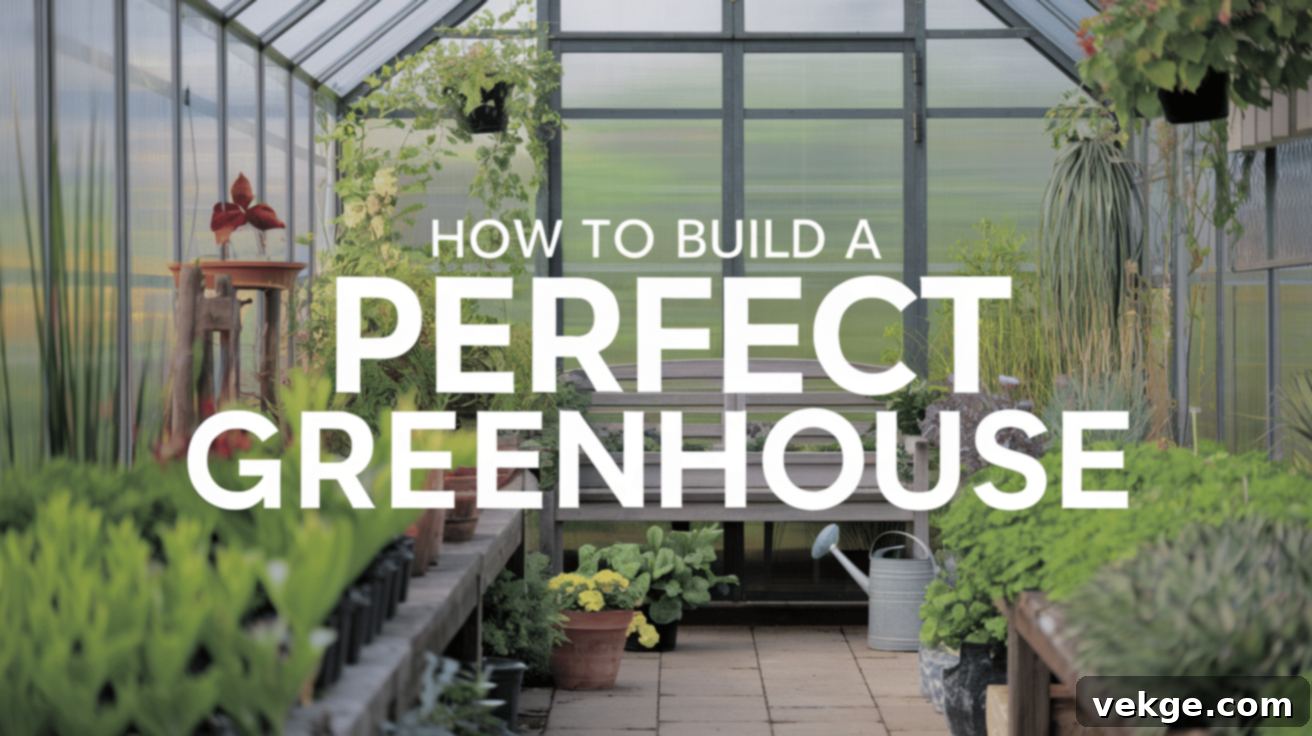The Ultimate Guide to Building Your Own Greenhouse: Design, Materials, Budget, and Care for Thriving Plants
A greenhouse is more than just a structure; it’s a gateway to year-round gardening possibilities, offering a controlled environment where your plants can flourish regardless of the external climate. It allows you to extend your growing season significantly, enabling you to start seedlings earlier in spring, cultivate delicate plants that wouldn’t survive your local weather, and even harvest fresh produce deep into winter. Beyond extending seasons, a greenhouse provides vital protection against harsh weather conditions like frost, heavy winds, and torrential rain, while also safeguarding your precious crops from pests and curious animals.
For gardeners eager to push the boundaries of their planting potential, a greenhouse opens up opportunities to grow exotic species or simply ensure a bountiful harvest. In this comprehensive guide, we will walk you through every essential step of creating your own greenhouse. From understanding fundamental design principles and selecting the right materials to managing costs and implementing effective maintenance strategies, our focus is on providing practical, actionable advice. Our goal is to empower you to construct a greenhouse that perfectly aligns with your gardening aspirations, local climate, and financial plan, ensuring a rewarding and sustainable growing experience.
Understanding the Core Principles of Greenhouse Design
A truly successful greenhouse begins with thoughtful design, a cornerstone that dictates its efficiency, longevity, and your plants’ health. The primary objective is to maximize natural sunlight, as light is the engine of photosynthesis. This means carefully considering solar orientation, understanding how the sun’s path changes throughout the day and across seasons, and ensuring your chosen design captures optimal light without causing overheating.
Beyond light, effective climate control is paramount. A well-designed greenhouse must integrate systems for regulating temperature and humidity, preventing extremes that can harm your plants. This includes strategic ventilation for cooling and fresh air, and potentially heating solutions for colder months. Furthermore, the structural integrity of your greenhouse cannot be overlooked. It must be robust enough to withstand local weather challenges, be it strong winds, heavy snowfall, or intense rainfall. Before embarking on construction, it’s crucial to define your gardening goals. Are you aiming for year-round cultivation, which demands more sophisticated heating and cooling systems, or simply looking to extend your seasonal growing window, which might allow for a simpler, more cost-effective structure? Clarifying your usage will significantly influence your design choices and overall investment.
Choosing the Perfect Location for Your Greenhouse
The site you select for your greenhouse is as critical as its design. An optimal location can dramatically enhance its performance and reduce operational costs. Generally, the best orientation for a greenhouse in the Northern Hemisphere is facing south or southeast, ensuring maximum exposure to direct sunlight throughout the day. Aim for a spot that receives at least six hours of direct sunlight daily, especially during the shorter, weaker sun days of winter, when every ray counts. Be mindful of potential shade sources; mature trees, buildings, or fences can cast shadows that limit light, particularly during crucial winter months. While some shade in summer might be beneficial to prevent overheating, winter shade is detrimental.
Beyond sunlight, practical considerations are vital. Assess the topography of your chosen area; a level ground is ideal, or one that can be easily leveled without extensive excavation. Proper drainage is non-negotiable to prevent water accumulation around the foundation, which can lead to structural damage and create an overly humid environment inside. Lastly, convenience is key. Ensure your greenhouse is easily accessible for daily tasks like watering, tending to plants, and harvesting. Proximity to water sources is essential for irrigation, and if you plan to use electric fans, heaters, or automated systems, convenient access to electricity will save you considerable time and effort in the long run.
Innovative Greenhouse Ideas to Inspire Your Project
1. Lean-to Greenhouse: Space-Saving and Efficient
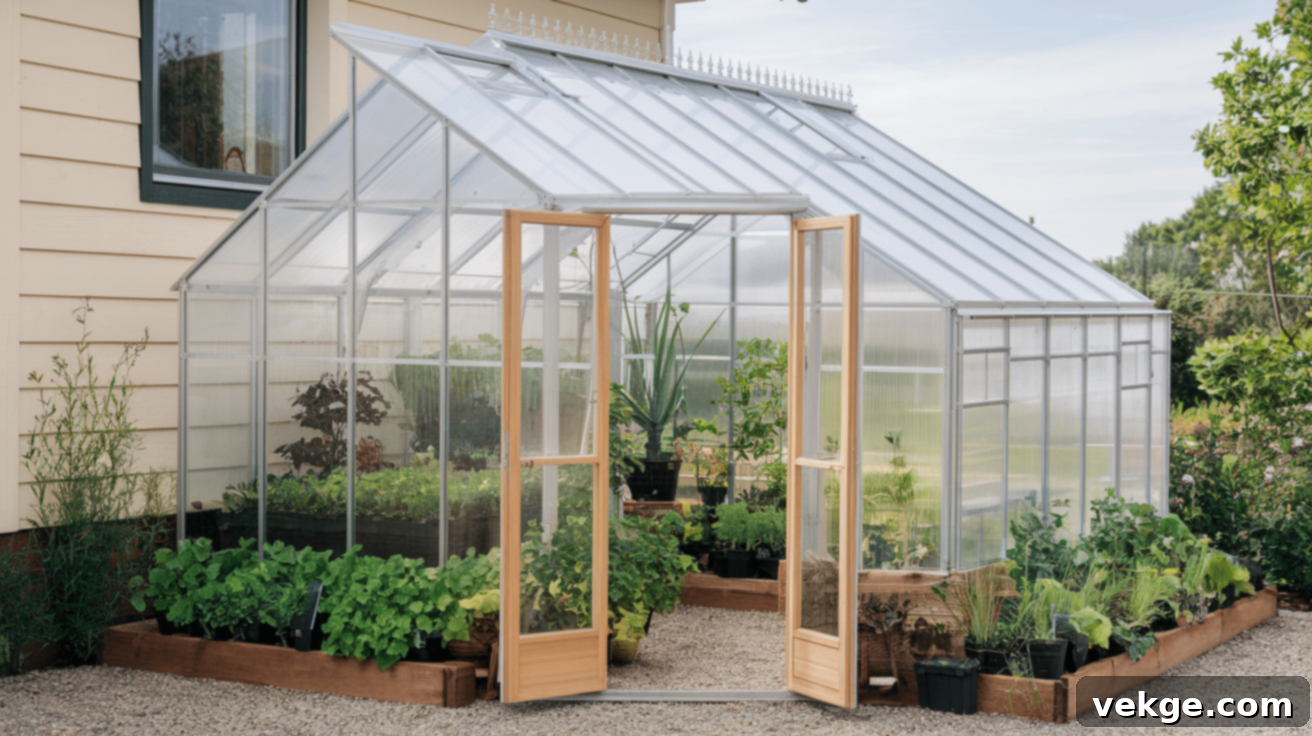
The lean-to greenhouse is an excellent choice for gardeners with limited space or those seeking a more budget-friendly option. This design is characterized by its reliance on an existing structure, such as a wall of your home, garage, or shed, to form one side of the greenhouse. This means you only need to construct three new walls and a roof, significantly reducing material and labor costs compared to a freestanding unit. A major advantage is the thermal mass provided by the adjoining building wall, which absorbs heat during the day and radiates it back into the greenhouse at night, helping to stabilize internal temperatures and reduce heating needs.
Lean-to greenhouses are particularly well-suited for smaller urban gardens or for beginners looking to experiment with greenhouse gardening without a massive initial investment. They can be remarkably compact, with dimensions as small as 4×8 feet, yet still offer ample space for growing a variety of plants, starting seedlings, or overwintering tender specimens. Their direct attachment to your home also offers convenient access to utilities like water and electricity, making daily maintenance simpler and more efficient.
2. Geodesic Dome Greenhouse: Strength and Optimal Airflow
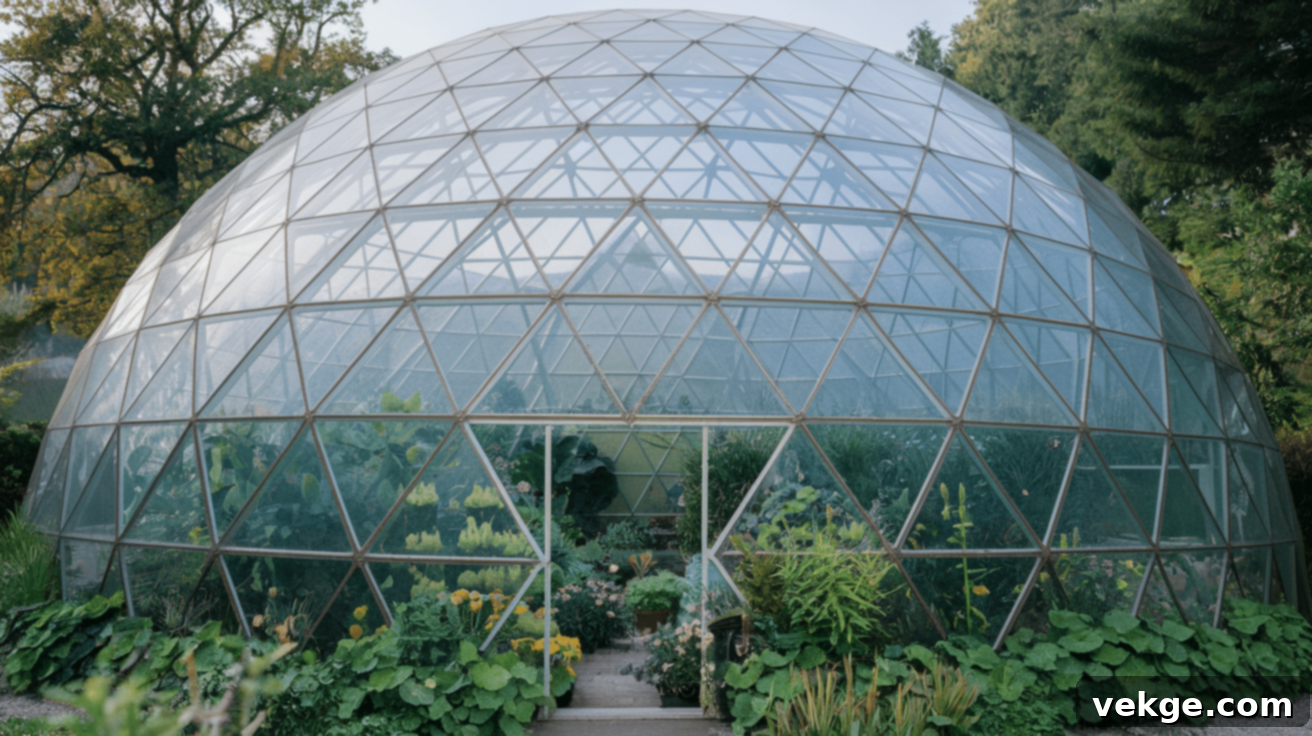
For those seeking a structure that combines exceptional strength with unique aesthetics, the geodesic dome greenhouse is an intriguing option. This distinctive rounded structure is constructed from a network of triangular panels, creating a highly stable and incredibly resilient dome shape. Its inherent design makes it remarkably resistant to high winds and heavy snow loads, making it an ideal choice for areas prone to harsh weather conditions. The dome’s geometry promotes highly efficient air circulation, allowing heat to rise and distribute more evenly throughout the interior, which can lead to more consistent temperatures for your plants.
The spherical shape of a geodesic dome also optimizes internal growing space. Plants can be tiered at various heights, maximizing vertical growing area, and the even light distribution across its curved surfaces can benefit plants from multiple angles. While the complex appearance might suggest a difficult build, many companies offer pre-fabricated kits with clear instructions, simplifying the assembly process for DIY enthusiasts. Furthermore, the dome’s minimal surface area relative to its internal volume contributes to better thermal efficiency, potentially leading to lower heating costs compared to traditional rectangular greenhouses.
3. Underground or Walipini Greenhouse: Harnessing Earth’s Insulation
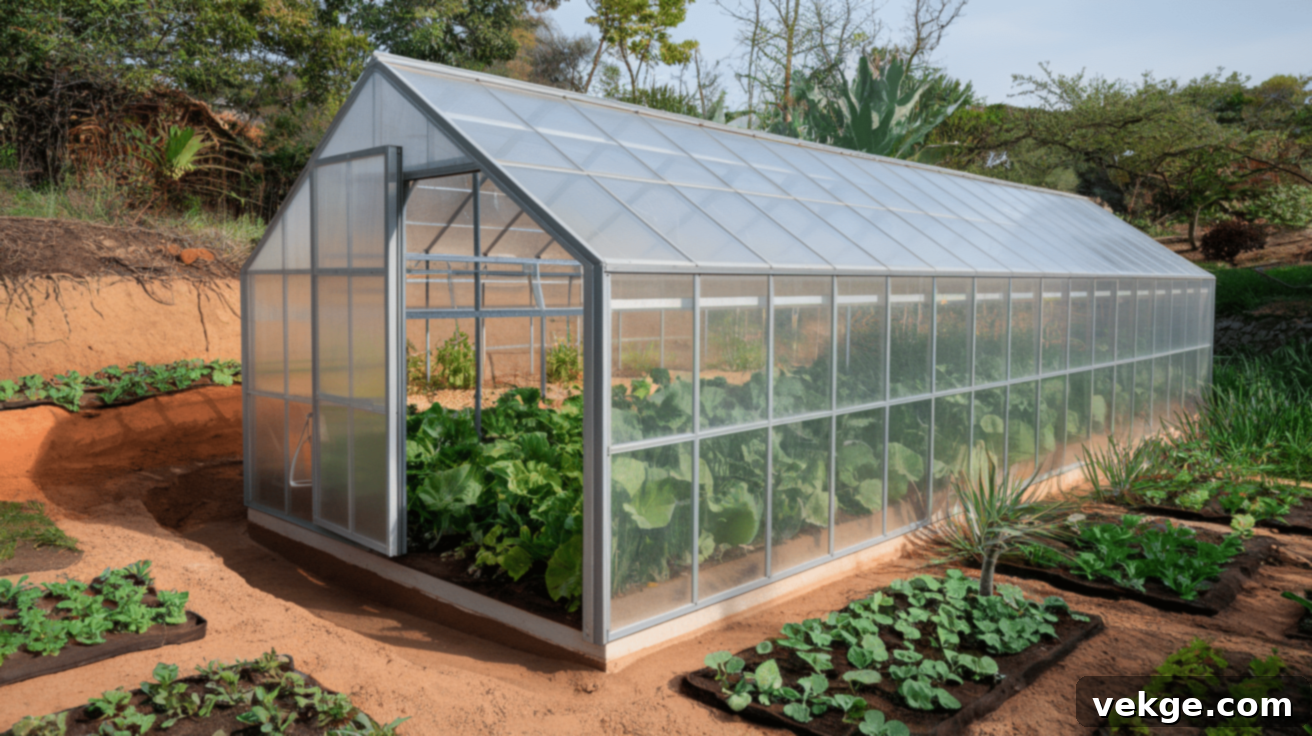
The Walipini, or pit greenhouse, is an innovative and highly sustainable design particularly effective in colder climates. This unique structure is built partially or entirely below ground level, leveraging the earth’s natural insulating properties to maintain a stable interior temperature. The ground acts as a massive thermal mass, absorbing heat during the day and slowly releasing it at night, significantly reducing the need for artificial heating and cooling systems. The design typically features a sloped, clear south-facing roof or front wall to maximize sunlight penetration, while the remaining walls are subterranean, utilizing the earth as insulation.
This “earth-sheltered” approach makes Walipini greenhouses exceptionally energy-efficient, often costing considerably less to heat than conventional above-ground structures. They excel at extending the growing season by months, or even enabling year-round cultivation of warm-weather crops in regions where this would otherwise be impossible. While construction involves significant excavation, the long-term savings in energy consumption and the enhanced growing capabilities make the Walipini an attractive and environmentally friendly option for serious gardeners in challenging climates. Proper drainage and waterproofing are critical considerations during its construction to prevent moisture issues.
Selecting the Best Materials for Your Greenhouse
The choice of materials profoundly impacts your greenhouse’s durability, efficiency, and overall cost. Carefully consider both the glazing (the transparent covering) and the frame materials to ensure they meet your specific needs and local climate conditions.
Glazing Options: Light, Insulation, and Durability
The covering material is crucial for light transmission and insulation:
- Glass: Known for its aesthetic appeal and superior light transmission, glass offers the clearest view and longest lifespan. It doesn’t yellow over time and is easy to clean. However, it is heavy, making installation more complex and requiring a stronger frame. It’s also fragile, breaks easily, and offers poor insulation compared to multi-wall plastics, leading to higher heating costs.
- Polycarbonate: A popular choice, polycarbonate is a strong, impact-resistant plastic that insulates much better than glass, especially in multi-wall configurations (e.g., twin-wall or triple-wall sheets). It diffuses light, reducing hot spots and sunburn on plants. It’s lighter than glass, easier to install, and typically lasts 10-20 years. While durable, it can scratch and some types may yellow slightly over many years of UV exposure.
- Polyethylene Film: The most affordable and lightweight option, polyethylene is a flexible plastic film available in various thicknesses. It’s easy to install and replace, making it ideal for temporary or low-budget greenhouses. However, it offers the least insulation unless double-layered with an air gap, has the shortest lifespan (2-5 years before needing replacement due to UV degradation), and is prone to tearing.
- Acrylic: Similar to polycarbonate but with superior clarity and gloss, acrylic panels are resistant to yellowing and offer good light transmission. They are lighter than glass but can be more prone to scratching than polycarbonate. Acrylic offers good insulation and can last for decades, but it is generally more expensive than polycarbonate.
- Fiberglass: These panels are tough, lightweight, and excellent at diffusing light, which can prevent plant scorching. They offer good durability but can become cloudy or yellow over time due to UV exposure, reducing light transmission and requiring periodic replacement. Their rougher surface can also trap dirt, making cleaning more challenging.
Frame Materials: Structural Support and Longevity
The frame provides the structural backbone of your greenhouse:
- Wood: Offers a natural, aesthetically pleasing look and provides decent insulation. Cedar and redwood are popular choices due to their natural resistance to rot and insects, but they come at a higher cost. All wood frames require regular treatment (sealing, painting, or staining) to prevent rot, warping, and insect damage, making it a more maintenance-intensive option.
- Galvanized Steel: Extremely strong and durable, galvanized steel frames can support heavy snow loads and withstand strong winds, ensuring a long lifespan. The galvanization process provides a protective zinc coating that resists rust. However, steel is a good conductor of heat and cold (thermal bridging), meaning heat can easily escape through the frame, potentially increasing heating costs. It’s also heavier and more difficult to work with for DIY builders.
- Aluminum: A popular choice for commercial and home greenhouses due to its lightweight nature, strength, and complete resistance to rust. Aluminum frames require very little maintenance and are easy to assemble, especially with pre-fabricated kits. While it conducts heat, its lighter weight often translates to less material needed, making it a practical and long-lasting solution, though initially more expensive than wood or PVC.
- PVC Pipes: An incredibly affordable and easy-to-work-with material, PVC is a favorite for small, temporary, or beginner greenhouses. It’s lightweight, flexible, and requires no maintenance. However, PVC is not as strong or durable as metal or wood frames, making it less suitable for large structures or areas with extreme weather. It can also become brittle over time with prolonged UV exposure.
Optimizing Your Greenhouse: Floor Options and Essential Drainage
The flooring of your greenhouse is more than just a surface; it plays a crucial role in maintaining cleanliness, controlling humidity, and even regulating temperature. A well-chosen and properly installed floor can significantly enhance the functionality and ease of maintenance of your growing space:
- Gravel: One of the most common and cost-effective flooring solutions. Gravel provides excellent drainage, preventing water from pooling and reducing fungal growth. It also helps moderate humidity by slowly releasing moisture into the air. Furthermore, dark-colored gravel can absorb solar heat during the day and radiate it back at night, contributing to thermal stability. Ensure a weed barrier is laid beneath the gravel.
- Concrete: A highly durable and permanent option that offers a clean, solid surface. Concrete is easy to sweep and sterilize, making pest and disease management simpler. It also acts as an excellent thermal mass, absorbing heat. However, it’s more expensive to install, provides no natural drainage, and requires the installation of dedicated floor drains to prevent water buildup. Non-slip finishes are advisable.
- Wood Decking: Provides a comfortable and aesthetically pleasing surface to walk on. Wood decking, especially if slightly spaced, allows for some drainage. It’s important to use pressure-treated or naturally rot-resistant wood (like cedar or redwood) to withstand the high humidity and moisture in a greenhouse environment. Regular maintenance will be required to prevent rot and pest infestation.
- Bricks or Pavers: These offer a charming and traditional look while providing good thermal mass, much like concrete. They absorb solar heat during the day and release it slowly at night. When laid with small gaps, bricks or pavers allow for effective drainage, preventing standing water. They are durable, easy to clean, and less permanent than concrete, allowing for future modifications.
Regardless of your chosen floor material, effective drainage beneath and around the greenhouse is paramount. This prevents foundation issues, root rot in plants, and the proliferation of mold and mildew.
Advanced Climate Control and Ventilation Strategies
Maintaining the ideal internal climate is crucial for plant health and productivity. Plants thrive within specific temperature and humidity ranges; deviations can lead to stress, stunted growth, or even death. Effective climate control involves a balance of ventilation, heating, cooling, and humidity management.
Ventilation is perhaps the single most important aspect of greenhouse climate control. It allows hot, stale air to escape, introduces fresh, CO2-rich air, and helps regulate humidity. Options range from simple manual roof vents, side vents, and doors to sophisticated automated systems. For more precise control, especially in larger greenhouses or hotter climates, consider installing electric exhaust fans that are thermostatically controlled, activating automatically when the temperature exceeds a set point. Intake vents, often louvered, should be placed low on the opposite side to encourage cross-ventilation.
In colder climates, heating becomes essential to extend your growing season through winter. Choices include electric heaters (easy to install but can be costly to run), propane or natural gas heaters (efficient but require proper ventilation for combustion byproducts), or more sustainable passive solar heating systems. Passive systems often utilize thermal mass elements like large water barrels, dark-colored stones, or concrete floors that absorb solar radiation during the day and slowly release stored heat throughout the night. For energy efficiency, proper insulation, weather stripping, and sealing are also critical.
Humidity control is equally important. Excessive moisture can foster fungal diseases and create an unhealthy environment. Good airflow facilitated by ventilation helps significantly. However, in particularly humid conditions, especially during cool nights, a dehumidifier might be necessary. Conversely, in very dry climates, a misting system or simply keeping a gravel floor wet can help increase humidity for moisture-loving plants. Monitoring both temperature and humidity with accurate sensors is key to fine-tuning your climate control strategy.
Sustainable and Eco-Friendly Greenhouse Solutions
Building an eco-friendly greenhouse not only benefits the planet but can also significantly reduce your long-term operational costs. Incorporating sustainable practices from design to daily management is a smart approach for the conscious gardener.
Using Recycled and Reclaimed Materials
One of the most impactful ways to make your greenhouse sustainable is by utilizing recycled or repurposed materials. This reduces waste, conserves resources, and can dramatically cut down construction expenses. Look for:
- Old windows or doors: Excellent for crafting unique and charming greenhouse walls, offering character and light.
- Reclaimed lumber: Salvaged from old barns, fences, or construction sites, it can be used for framing, providing strength and a rustic aesthetic.
- Repurposed containers: Old tires, plastic barrels, or even bathtubs can be ingeniously transformed into raised plant beds, water storage, or thermal mass elements.
- Other creative materials: Some ingenious gardeners have constructed entire greenhouses from plastic bottles (for insulation and light diffusion), old CDs, or even discarded shower doors, demonstrating the vast potential for creative reuse.
Using these materials requires creativity and sometimes extra effort to adapt them, but the result is a unique, character-filled greenhouse with a significantly reduced environmental footprint.
Eco-Friendly Heating and Cooling Techniques
Minimizing energy consumption for climate control is central to a sustainable greenhouse. Several natural and low-impact methods can effectively regulate temperature:
Solar-powered fans and vents offer an excellent way to regulate internal temperatures without drawing from the grid. These systems automatically activate when the greenhouse heats up, expelling hot air and drawing in cooler air, thereby reducing the need for electric cooling and ensuring consistent airflow for plant health. This passive approach harnesses the sun’s energy to manage its heat.
Compost heaps located inside the greenhouse serve a dual purpose: they provide a nutrient-rich soil amendment and generate a significant amount of heat as organic matter decomposes. Strategically placing a well-managed compost pile can contribute to maintaining stable temperatures during colder months, creating a microclimate that benefits plants while recycling garden waste.
Thermal mass elements are fundamental to passive heating. Materials like large water barrels (painted dark for better heat absorption), dense stones, or concrete floors absorb solar heat throughout the day. As temperatures drop at night, these elements slowly release the stored heat, stabilizing the greenhouse’s internal temperature and protecting plants from cold snaps. This natural heat regulation reduces reliance on active heating systems.
Finally, earth-berming—the technique of building your greenhouse partially into a hillside or mounding earth against its external walls—provides exceptional natural insulation. The surrounding earth acts as a buffer against extreme external temperatures, significantly reducing heat loss in winter and heat gain in summer. This method not only lowers heating and cooling costs but also protects the structure from harsh weather conditions, enhancing its overall resilience and sustainability.
Budgeting and Cost Breakdown for Your Greenhouse Project
The cost of building a greenhouse can fluctuate widely, influenced by factors such as size, chosen materials, whether you opt for a DIY kit or custom build, and the extent of additional features. Careful budgeting is essential to ensure your project remains feasible and meets your financial expectations.
Estimated Costs for a DIY Kit Greenhouse (Approx. 8×10 ft)
A prefabricated kit offers a straightforward path to greenhouse ownership, often providing a good balance of cost and convenience.
- Basic aluminum/polycarbonate kit: $500 – $1,500
- Foundation materials (e.g., gravel, treated lumber base): $100 – $300
- Essential accessories (shelving, basic irrigation, thermometer): $200 – $500
- Total Estimated Cost: $800 – $2,300
Estimated Costs for a Custom-Built Greenhouse (Approx. 8×10 ft)
Building from scratch allows for greater customization and material choice but typically involves higher costs and more labor.
- Wood framing (e.g., cedar, redwood, treated pine): $300 – $600
- Covering material (polycarbonate sheets, polyethylene film, glass): $200 – $1,000
- Foundation (concrete slab, brick pier, treated timber base): $150 – $500
- Hardware and tools (screws, nails, hinges, saws, drills): $100 – $300
- Essential accessories (shelving, basic irrigation, thermometer): $200 – $500
- Total Estimated Cost: $950 – $2,900
Note: These estimates do not include the cost of labor if you hire professionals for construction, which can add significantly to the total. Utilities (water, electricity hook-up) are also separate.
Money-Saving Tips for Your Greenhouse Build
To keep your greenhouse project within budget, consider these practical strategies:
- Start small and expand later: Begin with a modest size that meets your immediate needs and can be expanded as your gardening ambitions (and budget) grow.
- Build during the off-season: Material suppliers and garden centers may offer discounts on kits or building supplies during slower periods, such as late fall or winter.
- Check online marketplaces and salvage yards: Websites like Craigslist, Facebook Marketplace, or local architectural salvage yards can be treasure troves for used greenhouse kits, windows, doors, or lumber at a fraction of the cost.
- Ask local garden centers about end-of-season sales: They often clear out inventory, including greenhouse accessories, tools, or even display models, at significant markdowns.
- Do it yourself (DIY): Labor is a major cost. If you have the skills and time, tackling the construction yourself can save thousands of dollars.
- Prioritize essential features: Focus on the core structure, glazing, and basic ventilation first. Add automated systems, advanced heating, or elaborate shelving as your budget allows.
Essential Maintenance Tips for a Thriving Greenhouse
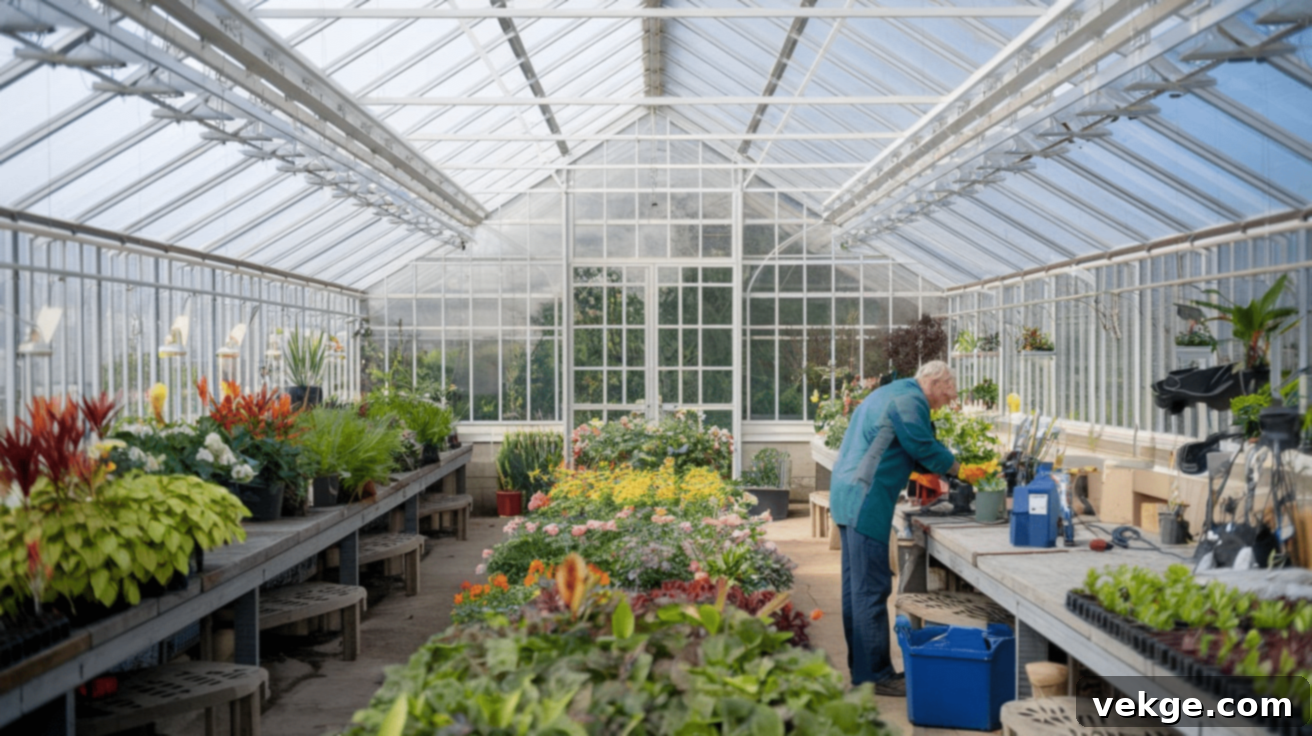
A greenhouse is an investment that, with proper care and attention, will provide years of gardening pleasure. Regular maintenance is key to keeping your plants healthy, preventing issues, and ensuring the longevity of your structure.
Preventing Plant Diseases in Your Greenhouse
Proactive measures are crucial to ward off diseases in the warm, humid environment of a greenhouse:
- Start with clean foundations: Always use fresh, sterile potting mix for new plants and thoroughly clean and disinfect all containers, trays, and tools before use. This dramatically minimizes the risk of introducing pathogens.
- Ensure adequate spacing: Avoid overcrowding your plants. Good air circulation between plants is vital to prevent fungal diseases like powdery mildew and botrytis, which thrive in stagnant, humid conditions.
- Master watering techniques: Water plants at their base, directly onto the soil, rather than splashing water on leaves. This reduces leaf wetness, a prime condition for fungal and bacterial growth. Water in the morning so any accidental leaf moisture has time to evaporate.
- Promptly remove affected plants: At the first sign of disease, immediately isolate or remove the affected plant to prevent the spread to healthy specimens. Dispose of diseased plant material away from your compost pile.
- Maintain tool hygiene: Regularly clean and disinfect your pruning shears, trowels, and other gardening tools, especially after working with a sick plant. A simple bleach solution or rubbing alcohol can prevent disease transmission.
- Good ventilation: As mentioned previously, consistent air movement helps reduce humidity levels around foliage, making it less hospitable for disease-causing organisms.
Effective Pest Management Strategies
Pests can quickly multiply in a greenhouse if not managed. A multi-faceted approach is most effective:
- Thorough inspection of new plants: Before introducing any new plant into your greenhouse, carefully inspect it for signs of pests (eggs, larvae, adults) or disease. Quarantining new plants for a few weeks can also be a wise precaution.
- Utilize sticky traps: Yellow sticky traps are excellent for monitoring and catching common flying pests like whiteflies, fungus gnats, and winged aphids, providing an early warning system.
- Introduce beneficial insects: Ladybugs, lacewings, and predatory mites are natural enemies of many common greenhouse pests. Releasing them can provide effective biological control, reducing the need for chemical interventions.
- Maintain a weed-free perimeter: Keep the area immediately surrounding your greenhouse free of weeds, as these can harbor pests that might eventually migrate indoors.
- Install fine mesh screening: Cover all vents and openings with fine mesh screening to act as a physical barrier, preventing larger insects from entering.
- Employ organic pest control solutions: For persistent infestations, consider organic options like insecticidal soap, neem oil, or horticultural oils, which are generally safer for plants, beneficial insects, and the environment than synthetic pesticides.
Structural Maintenance and Cleaning
Beyond plant care, the greenhouse structure itself needs attention:
- Regular cleaning of glazing: Algae, dust, and grime can accumulate on your glazing, reducing light transmission. Clean panels periodically with a mild soap solution to ensure maximum light reaches your plants.
- Inspect frame and foundation: Annually check your frame for signs of rust, rot, loose bolts, or warping. Address any issues promptly to prevent structural compromise. Ensure the foundation is stable and free from water pooling.
- Check and clear gutters: If your greenhouse has gutters, keep them free of leaves and debris to ensure efficient water runoff and prevent leaks.
- Seal gaps and cracks: Inspect for any drafts, gaps, or cracks in the glazing or frame, especially before winter. Seal them with appropriate weatherstripping or sealant to improve insulation and energy efficiency.
Seasonal Greenhouse Tasks
- Winterizing: Before cold weather sets in, ensure heaters are working, insulation is intact, and any vulnerable plants are protected. Consider adding additional layers of bubble wrap insulation for extreme cold.
- Summer preparation: As temperatures rise, prepare for cooling. Install shade cloths, ensure ventilation systems are operational, and consider evaporative coolers or whitewash for heat reduction.
Conclusion
Embarking on the journey of building your own greenhouse is a decision that can profoundly transform your gardening experience, extending your growing capabilities and offering a sanctuary for your plants throughout the year. By meticulously considering the fundamental aspects of design, such as solar orientation and structural integrity, and carefully selecting materials that suit your climate and budget, you lay a robust foundation for a successful growing environment. Whether you opt for a compact lean-to, a resilient geodesic dome, or an energy-efficient walipini, tailoring the structure to your specific needs is paramount.
Remember, your greenhouse doesn’t have to be a masterpiece from day one. Many successful gardeners start with simple, cost-effective solutions and gradually enhance their structures with advanced features as they gain experience and resources. The key is to begin, learn, and adapt. With diligent planning, an understanding of basic climate control principles (light, temperature, and moisture), and consistent maintenance – including disease prevention, pest management, and structural upkeep – your greenhouse will not only become an invaluable asset to your garden but also a source of immense satisfaction and bountiful harvests for countless seasons to come. Embrace the possibilities, and watch your gardening dreams flourish under glass.
